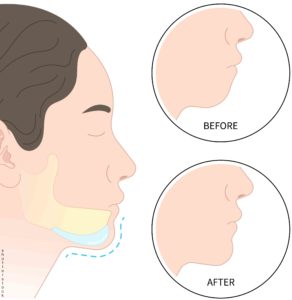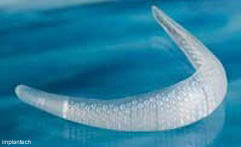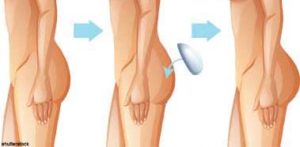PATIENT INFORMATION: Aesthetic / Contour Implants
checklists for contouring implants: deutsch english francais espagnol
for breast implants see here
WHAT … FOR? (Indications)
Esthetic or contouring implants change the outer contour of the body by augmentation. They are used most of the time for esthetic reasons, but they can be helpful for functional disorders too.

nose implant
In addition to breast implants (⇒), implants are used in the following interventions:
- Reconstructions after tissue defects caused by accidents or tumor surgery
- Deformities from birth or maldevelopment
- Leg correction (lenghtening, angle adjustment)
- Intramuscular gluteal implant (buttock augmentation)
- Facial Bone Contouring (for example chin, cheekbone, auricle)
- Nose contouring (rhinoplasty)
- Calf implant
- Pectoralis implant for men
- Testicular implant (⇒ see urogenital implants)
Not all aesthetic surgeries require implants. Some change contours (e.g. face lifting) or remove tissue (e.g. liposuction). These are not discussed here.


chin implant
TIMES
Augmentations done by bone correction in the facial skull or other body regions are stable – in the long run also dependent on function. Modern silicon implants are expected to keep for 15-20 years, but some have to be removed/replaced before.

gluteal implant (buttock implant)
RISKS (Contraindications)
Short term risks:
As with all surgical interventions: Inflammation, repulsion, injury of neighbouring structures, foreign body reactions, allergic reactions, rejection, hematoma, asymmetry.
Long term risks:
Dislocation, chronic inflammation, chronic pain, reoperation, scarring, implant removal.
Aesthetic disappointment
It may happen that the result does not meet the desired expectations. Then you have to decide whether you want to have it corrected.
Seroma
Seroma means fluid around the implant. It will be removed simply by draining with a needle.
Capsular Contracture
This happens always to a certain degree around silicone implants. The capsule around the implant squeezes it and forms a fibrous acr tissue. This can be painful and is the most common complication. The scar tissue can be removed in an additional surgery, sometimes several times.
Necrosis
Dead tissue may very rarely develop around silicone implants. This tissue has to be removed, sometimes with the implant. It can leave permanent scars.
In the case of implants for bone replacement, it is possible that the bony material will not be integrated into the body tissue and will have to be subsequently removed as dead material.
MATERIAL-RELATED PROBLEMS
Rupture: Silicone implants do not compromise daily life, but they are not indestructible. Most implants come with a lifetime manufacturer’s warranty that covers operational failure, but some events causing a rupture are not covered.
Anaplastic large cell lymphoma (BIA-ALCL) with certain textured is thinkable, but has so far only been described for breast implants

example: chin implant
MATERIALS AVAILABLE
Artificial, synthetic
- Tissue expander
(Used to prepare space for a definite implant) - Injectable filler
hyaluronic acids, collagens (origin pigs, cows, cadavers), biosynthetic polymers (calcium hydroxylapatite, polycaprolactone, polymethylmethacrylate, polylactic acid) - Saline implants (vulcanized silicone elastomer filled with salt water 0.9%)
- Silicone gel implants (vulcanized silicone elastomer filled with silicone gel)
- Solid silicone for sizing purposes (silicone, f.e. for pectoralis implants)
- Spacer for fracture repair, management of both cosmetic and post- traumatic facial deformities
- High-density porous Polyethylene
- Titanium plates, screws, maybe in combination with bone and soft tissue implants of different origin (see there).
Autologous material
Lipoinjection, Fat transfer, Bone transfer
Contours may be changed by transposition or corrective bone surgery. There are many different types of contour changing surgeries done in medical specialties like leg lengthening, facial esthetic and functional surgeries.
Titanium plates, screws, maybe in combination with bone and soft tissue implants of different origin (see there).
NUMBERS / STATISTICS
The ISAPS lists the following contouring surgeries in their statistics, which can use implants (globally, 2021):
Breast Augmentation (1,685,471)
Fat Grafting – face (589,494)
Buttock Augmentation (523,331)
Facial Bone Contouring (131,656)
Some of the interventions mentioned here are not statistically recorded, also because they are performed only rarely or are very individual.
This also applies to problem descriptions, which are difficult to generalize because they refer to individual cases.
MEDICAL SOCIETIES
see here
(as a patient you may watch for the patient information button ![]() in your regions language or the doctor finder button
in your regions language or the doctor finder button ![]() )
)
CRITICISM
- So far there is no evidence for causal connection between Silicone implants and either type of diseases.
- 20% of women after cosmetic implantation and 50% after breast reconstruction required explantation after 10 years (2011, FDA)
- Wenn das Brustimplantat krank macht (Deutsches Ärzteblatt, 118, 48, 03.12.2021
SELECTED PATIENT INFORMATION
FDA warns about illegal use of injectable silicone for body contouring
The UK’s Plastic Surgery Addiction – Infographic about plastic surgery addiction
Risiken von Silikonimplantaten e. V.
PATIENT CHECKLISTS
Questions to ask the surgeon about contour implants (english)
(deutsch) (español) (français)
IMPLANT PATIENT REGISTER (links)
Breast and Cosmetic Implant Registry (BCIR, U.K.)
Contour implants are not commonly recorded specially. You can ask if they are included in a breast implant registry or you can simply register it with us here.
In the register of the registries you can check which ones are available.
If your implant is not covered:
The Implant-Register offers registration of esthetic implants online (fee) and you can download a printable version (free) for your personal use.
You may also ask your implanting doctor to register for you on the doctor’s page.
You can share your experience here for the community by submitting it for statistical purposes (personal data will remain anonymous). You may also post your experiences directly on some product sites.
| Disclaimer The information and links and whatsoever shown on this page are compiled with care. However, Implant-Register can´t take any responsibility for the information given, nor their content, nor their up-to-date nature, particularly in interlinked pages. You may help us with your contribution, granting us the decision to publish or not. Be careful with conclusions for yourself, in doubt double-check and consider medical solutions are individual and have to be found with an educated medical person. |
